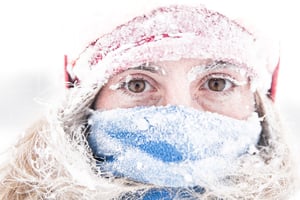 During the winter months, Mother Nature can stir up a variety of weather conditions. Howling winds, drifting snow, and freezing rain make travel, exercise, and day-to-day living difficult.
During the winter months, Mother Nature can stir up a variety of weather conditions. Howling winds, drifting snow, and freezing rain make travel, exercise, and day-to-day living difficult.
Unfortunately, more than one million people are injured each year due to winter weather. Here are some common winter injuries and tips to prevent them happening to you or your family.
Common winter injuries and tips to prevent them
1. Slip and falls
Concrete or asphalt surfaces can change with each step you take. A casual walk to your car or with your dog can suddenly turn into your body flailing out of control. If you’re lucky enough to catch yourself, you will probably keep walking and maybe look to see if anyone saw you. If you fall, common injuries can include:
- Broken bones
- Injured back
- Sprains
- Head injuries
If you fall and experience extreme pain or can’t get up, call 911 immediately. If you experience other injuries, visit your local emergency department or call your doctor. Loss of consciousness, severe headache, nausea, vomiting, and confusion can be signs of a severe head injury.
How to prevent yourself or others from falling:
- Shovel and salt your sidewalk frequently
- Use handrails if they’re available
- Avoid carrying items
- Keep your phone in your pocket
- Wear appropriate winter shoes
- Watch for slippery floors when you enter your home or a building
2. Frostbite
If you ask my neighbors, they’ll admit to seeing me shovel my sidewalk wearing only shorts, a jacket, and maybe flip flops. While they probably think I’m crazy, my thought is that I’m only going to be outside for a few minutes. Or, if you have high school kids, you know it’s not cool to wear a coat. In either foolish situation, frostbite can occur quickly.
Depending on the temperature, frostbite can occur within 10 minutes of exposure. Frostbite affects areas that are away from your core, including your feet, toes, hands, fingers, nose, and ears.
Like burns, frostbite has several degrees of injury. They are:
- Frostnip is a precursor to frostbite. Your skin may be very cold or numb and turn red.
- Superficial frostbite may cause your skin to become pale or white and can include the formation of ice crystals on your skin.
- Deep frostbite is irreversible and may include numbness, pain, and blisters. The dead areas of skin usually become hard and black.
Ways to protect you and your family from frostbite:
- Wear appropriate clothing and cover up your extremities.
- Wear moisture wicking socks if enjoying outdoor activities.
- Drink plenty of water.
- Avoid alcohol consumption.
3. Back injuries and heart attacks
Shoveling snow is very strenuous and can lead to significant injuries and even death. If you experience shortness of breath or chest pain, call 911 immediately.
Tips for more effective shoveling:
- Warm up your body by doing some stretches or brisk walking.
- Push the snow as much as you can and avoid lifting.
- Keep a slight bend in your knees to prevent back injury.
- Depending on the size of your property, consider hiring a snow removal service.
- Ask your neighbors for help.
4. Carbon Monoxide Poisoning (CO)
Carbon monoxide is an odorless, colorless gas that can lead to death. Carbon monoxide is produced by burning fuel in your car, grill, fireplace, or furnace.
Tips to prevent CO poisoning:
- When warming your car during winter, it’s safest to move it into your driveway. If you don’t, the gas fumes can enter your home.
- Have your gas, oil, or coal burning appliances inspected yearly by a qualified technician.
- During a power outage, don’t use a gas generator or portable heating device in your home.
- Install CO detectors in your home and change the backup battery in spring and fall.
5. Sports-related injuries
These injuries can happen very quickly. A fun family day at your local ski hill can end sadly with injuries.
Tips to ensure your day ends well:
- Know your limits.
- Wear appropriate equipment such as goggles or helmets.
- Stay hydrated and take frequent breaks.
- Pay attention to your surroundings.
6. Car accidents
While many of us have lived in a snowy climate our whole lives, many people forget the skills and level of caution needed to drive in adverse winter conditions. Check out the blogs below for ways to drive safely this winter.
Winter driving doesn’t need to be a white-knuckle experience
Sources:
https://www.healthline.com/health/frostnip
https://www.powerblanket.com/blog/stats-winter-related-injuries/
https://www.cdc.gov/carbon-monoxide/about/index.html





